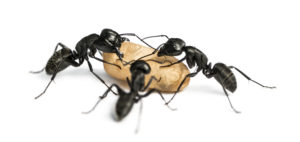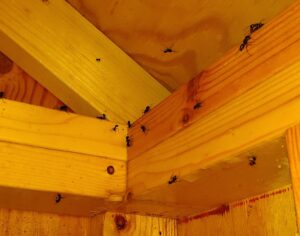Carpenter Ants
If you have seen large black ants around your home and yard, chances are you have seen carpenter ants hard at work. These are the largest pest ant here in Georgia. There are two varieties found in Georgia: one is the Black carpenter and the other is the Florida carpenter ant. Here in north Georgia, we usually see the Black carpenter ant since the Florida variety is more common in the southern and coastal areas of the state. The Black carpenter ant has a dull black color with yellow hairs on the abdomen area. There is a good bit of variety in size even amongst the species, so size alone is not the best way to identify the ants. They can be ¼ to ½ an inch long. Professional and licensed pest control companies or county extension agents are best at identifying ant species.

The carpenter ant is most active between March and October here in Georgia. There is a variation in the time depending on the weather in a given year. During the winter months, the ants hibernate in their nest to survive colder temperatures.
Outdoors, these ants can be found in hardwood trees. They are most active at night when they leave the nest in massive numbers to forage for food. Knotholes in trees are good nesting sites since they are commonly humid and protected from the weather. About 15 minutes after the sun goes down, you can often spot them traveling on their well-maintained trails. What do they like to eat? They enjoy the honeydew from aphids and other insects. This is almost purely sugar and is excreted by insects such as aphids during spring and summer.
Now, this all sounds fine. I live indoors. The ants live outdoors. All is well. Except when the ants decide to shop around for homes and being carpenters…they can build their home. All they need is a little moisture, a leaky soffit or damaged bathroom floors can be just the thing. Maybe the neighborhood got crowded or real estate prices have gone up…whatever the reason, the ants decide your home is their home. This is obviously not the best situation for the homeowner. So why would they move inside?
Carpenter ants are attracted to moisture-damaged areas. If you have wood damaged by water around your chimneys, under bathtubs, around dishwashers, and even under window sills, these are prime nesting areas for carpenter ants. Around door frames and in crawl spaces can be other welcoming areas. We have had customers with damaged porch columns, house eaves, and siding, all unwittingly supporting a nest of carpenter ants. Add warm temperatures, and you have a best-case scenario for carpenter ant infestation. So first things first, keep a careful eye on any areas with water damage. Repair those situations as quickly as possible to avoid future problems with ants and other problem pests…like termites (but that’s another article).

How do you know you have carpenter ants? Well besides looking for water-damaged areas, another common sign of carpenter ants is the resulting damage to wood. These ants chew wood (thus the name carpenter) to make their nest. Don’t confuse ants with termites. The ants are not eating the wood but only excavating to make galleries. Their jaws are strong and saw-like, easily chewing the wood. While termites line their galleries with mud, the carpenter ant leaves a smooth and clean tunnel with no debris or mud in evidence. As is the case with all pests and wildlife, having a trained and licensed professional to identify and solve the problem is essential.
It may seem obvious, but it should be said that the only way to get rid of carpenter ants is to find the nest and eliminate the source. But remember you have to repair the moisture problem that drew them there in the first place. Some people want to simply spray the visible ants and assume that will take care of the problem. This assumption will lead to frustration and a lengthening of the solution. Following the ants to the nesting area is a possible way to find the nest. The foragers are out in search of food for the colony and drop debris such as sawdust-type wood or discarded prey insect parts as they leave the nest.
It is possible for ants to come inside the home but still be nesting outdoors. As discussed earlier, most carpenter ants are nesting in large trees. In this case, the ants will trail up and down the tree and follow their trails to their food source. It is not unusual to find sawdust piled up at the base of a nesting tree since the ants are clearing the wood out for their galleries inside. The wood is simply discarded outside.
Most often the problem homeowners deal with is the presence of an interior nest. Again, water-damaged areas are the most likely culprits when finding carpenter ant nests inside the home. These ants will still have a “trail system” they establish inside your home, and seeing long lines of ants is usually common. The same wood particles can be found as evidence of their presence as well. Remember, finding the nesting area is absolutely essential to eliminating the problem.
After the nest has been found comes the removal process. Physical removal of the nest should be done by a licensed professional and then an appropriate insecticide for ant control applied. This can be dust or aerosol applied to voids where nesting is probable or where foraging is taking place. These products should be applied by a licensed pest control operator since they know the proper application procedure. All pesticides should be used carefully according to label directions. A commonplace to dust is behind electrical outlets and switch plates or under window sill voids. Small holes may be drilled to insert the product. If the nest is visible, an aerosol may be used to eliminate the pests. An important note is not to use water-based products in the voids of your home. These can cause mold, electrical shock, and damage to the drywall. Again, the pest professional who is licensed and trained is a homeowner’s best approach to ant control.
In some cases, the nest is not accessible. In these cases, the best approach may be the use of baits. Indoors and outdoors, baits can be successfully used in areas the ants have been seen foraging or on the well-used trails. The basic principle of baits is that the foragers pick up the attractive bait as food and take it back to the nest eliminating the source of the problem.
Eliminating carpenter ants can be a long process, and there are ways to prevent the problem in the first place. Water damage has already been mentioned. Inspection of your home’s general welfare should be performed on a regular basis to find problems areas before the insects do. Another proven method of prevention is regular pest control which includes perimeter treatments. These treatments discourage the ants from entering the structure in the first place. Regular pest control will concentrate on keeping the doors and windows properly treated to protect your home. Also, keep shrubbery and mulch and trees at least a foot of air space all the way up and away from your home so they don’t bridge over to your home. Treetops that touch your roof are a common bridge for the insects to get to your eaves and roof. Keep them trimmed back as much as possible to avoid problems.
If you are having trouble with carpenter ants, give us a call at Canton Termite and Pest Control. We are your hometown pest control company and want to help you protect your home and family from uninvited guests.
Call us today for a free estimate at 770-479-1598!
By: Robin
